Ioniq gives Hyundai advanced EV and hybrid
Filed under: Equinox, Autos
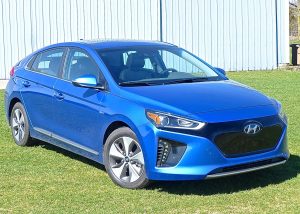
Ioniq offers stylish body on dedicated platform with buyers’ choice of pure electric, hybrid, or plug-in hybrid power.
By John Gilbert
ANN ARBOR, MI.
If the Hyundai Ioniq came out as a stylish new compact car, its sleek and aerodynamic looks, roomy interior, quick and agile performance, and smooth ride would undoubtedly make it a big hit at a base price of $22,200.
But it’s not a mainstream car. Far from it. It has all those above attributes, but it becomes a truly unique vehicle by being offered in a choice of three alternative powertrains. After a brief chance to aggressively road-test two of the Ioniq models, the impression it leaves is — in a word — electrifying.
I asked Hyundai officials if we were all going to be driving electric cars in the near future, or are hybrids a viable alternative. The consensus is that we are headed for electric-powered cars, but it will be a number of years before they take hold, which means hybrids and plug-in hybrids might make the most sense right now. Taking no chances, Hyundai is offering all three alternative powertrains in the new Ioniq.
Apprehensions from preconceived ideas can get in the way of buying a hybrid vehicle, much less a pure-electric one, and while Hyundai officials are aware of all the reasons buyers have for not buying such an alternative-energy car, they have designed the Ioniq to conquer all of them.
The Ioniq is the first car with a dedicated platform — shared with the new Elantra — designed to offer the choice of the most efficient hybrid in the industry, the most progressive plug-in hybrid in the industry, or the most environmentally sound and efficient pure-electric car in the industry.
That’s a lot of firsts, but ever since Hyundai made technical breakthroughs in engine, fuel injection, transmission efficiency, and design development nearly a decade ago, we shouldn’t be surprised by what those creative engineers in Seoul, South Korea, might come up with.
“The best thing is it looks like a regular car, and it drives like a regular car,” said Mike O’Brien, vice president of products for Hyundai Motors America.
I beg to differ. When my driving partner and I took off on the twisty and not always smooth roadways near Ann Arbor, we drove the Ioniqs harder than a normal citizen might drive. We wanted to push the Ioniq to see if it was just another alternative-energy car or truly something special. My vote was the latter.
If I there was a conventional engine under the hood, I would have been impressed that the Ioniq swept around tight, even blind, curves, always with the car following dutifully and with precision to all steering inputs. The fact that it was pure electric made it all the more impressive when it stayed level, never lurched, and handled the numerous road irregularities we flew across with nary a hint of harshness, looking high-style from every angle.
When my turn was finished, I found the passenger bucket seat supportive and comfortable in all circumstances, and it gave me a better chance to admire the smooth and high-end look and feel to the seats, dashboard and numerous features. They use wood chips and bits of volcanic rock to make the soft and supple top on the dashboard, for example. And they found a way to mix soybean oil into the paint, as another example of making the car sustainable.
The basic Ioniq Hybrid starts at a mere $23,000 including destination, its 1.6 engine helping recharge the battery pack. The plug-in Hybrid next up the scale, while the top-end, pure-electric version starts at $29,500. The EV will have no gas-engine safety net, but it will have a range of 124 miles before needing a recharge. It has a larger electric motor system, and a potent version of the LG Chem battery pack that develops 88 kW, the equivalent of 118 horsepower and 218 foot-pounds of torque, which collaborate to send the car rocketing away from a stop with startling potency.
There are other dazzling EVs newly on the market, such as the Tesla, the Chevrolet Bolt, Nissan Leaf, and BMW i3. The Bolt has a range of 238 miles, which is very impressive, and the Tesla also has excellent range. O’Brien, however, referred to industry standards for thermal efficiency, which take into account such things as the carbon footprint. Since 67 percent of our electric energy comes from fossil fuel or coal, the reality is that electric power may seem free, but nothing is free.
“Ultimately, we’re going to have to reduce our carbon footprint,” O’Brien said. “They call it an ‘MPGe’ equivalent, and by that calculation the Ioniq is the most efficient EV with a 136 MPGe, which beats the i3, the Bolt, and all other EVs on the market.”
O’Brien explained the assets of the three-pronged answer to all the alternative-energy challenges by first enumerating the challenges.
“While hybrid and electric vehicles have been around for awhile, it’s still a fact that 97 percent of buyers have not bought them,” said O’Brien. “That means only 3 percent are choosing hybrids or electric vehicles. We seem to be stuck on that number. The reasons consumers give for avoiding hybrids are: cost, lack of performance, boring, maintenance worries, not sporty enough, and insufficient passenger or cargo room.
“When you look under the hood of a Camry or Accord hybrid, you see all kinds of extra space, because the platform was designed for a larger engine. With a dedicated platform, and using a small engine with the hybrid, means we didn’t need all that space. So we moved the cowl forward, reducing the size of the engine compartment, and creating a much more spacious interior. Our hybrid has a total interior volume of 122.7 cubic feet, and our plug-in hybrid and EV have 120 cubic feet.”
In addition, Hyundai worked with LG Chem, the South Korean electronics giant that designed and built the battery pack for the Chevrolet Volt, and the new Chevrolet Bolt pure-electric, as well as for Hyundai, Kia and other hybrid car-makers. The streamlined design of the battery pack, with vertical plates, and a lithium ion polymer structure, make it lighter and smaller and able to be form-fit into odd areas. And lithium-ion-polymer battery packs generate more power, hold the charge longer, and recharge more quickly.
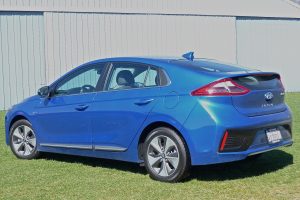
Battery pack location under rear seat provides mid-car weight balance, full 122.7 cubic feet of cargo space.
Other hybrid car-makers fit the battery pack under the trunk, which greatly cuts down the cargo room, and, being heavy, gives most hybrids an odd weight-distribution. Hyundai engineers designed the Ioniq with the battery pack under the rear seat, leaving full trunk space, and creating a lower center of gravity and a mid-engine feel that enhances steering and contributes to good handling.
Hyundai engineers also revised their well-proven 1.6-liter Kappa 4-cylinder, a dual-overhead-camshaft gem with direct injection that can make compact cars, midsize cars, and even the Tucson compact SUV perform admirably, with a turbocharger in some cases. In the Ioniq, it is altered with Atkinson-cycle technology that keeps the intake valves closed a bit longer, and delays the opening of the exhaust valves. That allows the air-fuel mixture more time to more fully ignite, resulting in greater thermal efficiency, and extra power. With the hybrid, the engine doesn’t need extra power, because the electric motor supplements any need for power.
In the Ioniq Hybrid, the 1.6 has 104 horsepower at a high 5,700 RPMs, and 109 foot-pounds of torque at 4,000 RPMs. The electric motor adds 32 kW (43 horsepower) for a 125 horsepower maximum, and its 125 maximum added torque combines for a 139 foot-pound punch.
The biggest surprise to many traditionalists is that electric motor power is more efficient than a gas engine. It has 100 percent of its torque at zero RPMs, so stepping hard on an electric car’s “gas” pedal can snap your head back by surprise. In the Ioniq Hybrid, the electric motor’s instant torque aids low-end power, and if you need extra power at high speed, the electric power can continue to supplement the 4-cylinder up to 75 miles per hour.
After being thoroughly impressed with the pure-electric Ioniq, we also drove the base-model hybrid, which also drove well, with quick acceleration, and good steering and handling. Unlike nearly all other hybrids, the Ioniq Hybrid does not use a CVT, the continuously variable transmission that uses belts and pulleys to seamlessly shift, but leaves the unsatisfying feeling of “motorboating” instead of tangible shift points.
Hyundai engineers equipped the Ioniq with their own 6-speed dual-clutch transmission that shifts swiftly and with a decisive sportiness, whether you like paddles or just switching to “sport” to hold shift points higher. The “eco” setting upshifts earlier for better economy, and the Ioniq Hybrid comes away with everyday fuel economy of 59 highway, and 58 mpg combined city-highway. That beats the Prius and all other hybrids, as does the Ioniq’s thermal efficiency that means 40 percent of all its energy goes to its wheels, which are shod with specially designed Michelin tires.
We didn’t get to drive the plug-in hybrid, which is yet to be introduced as the third electrified system. That will move up from the Hybrid’s 32 kWh with 43 horsepower, to 45 kWh, and 60 horsepower. With more electric motor power in the mix, when fully charged it will go 27 miles on electric only, before the gas engine kicks in seamlessly to help.
Both hybrids share the 6-speed dual-clutch transmission. The plug-in Hybrid has a more powerful charger. You can connect to normal household outlets, but if you use the quick-charge system you can recover 80 percent of a full charge in 23 minutes, a fast charge that will let you cover another 99 miles.
All available safety items, including standard rear camera, and the availability of lane-change devices, are included, and the Ioniq also has all the latest in connectivity features.
I am eager for a longer test-drive, but the first impression will be hard to shake. The Ioniq beats the tests of cost, sportiness, being not boring, being not sporty, and having insufficient interior room.
If maintenance worries still exist as the last concern, how about this: Along with Hyundai’s usual 10-year, 100,000-mile engine warranty, there is a lifetime warranty on the battery pack.
I kidded O’Brien that if the Ioniq doesn’t quite meet fuel-efficiency figures, they could come out with a Type R and insert a tiny “R” between the “I” and the “O” to make it an “Ironiq.” He didn’t laugh. After driving the car, I’m more inclined to suggest they might need to insert a small “C,” because the new car could indeed become Iconiq.
Jeep Compass still here, finds bold new path
Filed under: Weekly test drives, Autos
By John Gilbert
Jeep’s ever-expanding world of hardy, all-terrain vehicles, the descending order of size and capability has been: Grand Cherokee, Cherokee, Patriot, Compass, Renegade, Wrangler. Or something like that, with the Wrangler probably the most capable off-roader, but also the most limited as far as all-purpose highway use goes.
When the Cherokee came out, it was an instant knockout, selling like hotcakes because it would do all the things the Grand Cherokee would do on the road, and would come close to duplicating the Wrangler’s off-roading. When the Renegade came out, as a cute, squarish little Jeep, it also proved surprisingly capable and is a great example of hoe effective the collaboration between Jeep and Fiat can be.
All of which made me think that the Patriot and Compass were probably destined to be eliminated. The Compass has been a lightweight vehicle, good for commuting and moderate foul-weather usage, but nowhere near as hardy as the Cherokee above it and the Renegade below.
Shows what I know.
For 2017, Jeep not only is keeping the Compass around, it has given it an entirely new life, from every standpoint — looks, styling, and capability. In fact, some critics think the narrow-eyed Cherokee looks like a rebel among the other Jeep vehicles, and for them, the new Compass takes on a more traditional Jeep look. You could make the case that the Compass now looks like a downsized Grand Cherokee.
Recently I was able to live with a new Compass for a week of driving on the cliffside hills of Duluth and the gently winding roadway along the North Shore of Lake Superior. In traffic and up hills, the Compass performed very well, never lacking for power or performance.
Under the hood is the now-familiar 2.4-liter Tigershark 4-cylinder engine, a jewel of a powerplant originally designed in joint venture by Hyundai in South Korea and used by Mitsubishi as well as Chrysler as its base engine for compact cars. With Fiat ownership, the adaptation of that company’s brilliant MultiAir system works fantastically well on the 2.4. That system starts with dual overhead camshafts, one for intake and one for exhaust, and then eliminates the intake cam, instead using a system of oil-filled tubes that connect exhaust valves with intake valves. Everytime the exhaust valves work, they force the intake valves to work too, in computer-perfect concert.
The result is an almost-turbocharged like increase in power and performance. As tested, the 2.4 with MultiAir2 offers 180 horsepower and 175 foot-pounds of torque — easily enough to send the Compass Latitude 4X4 on its appointed rounds, aided by its 9-speed automatic transmission. Read more
New Impreza hidden in plain view
Filed under: Weekly test drives, Autos
By John Gilbert
After pulling into the Target parking lot, I dropped off my wife, Joan, and engaged in my usual parking-lot gamesmanship, wherein I circle a couple of times just to see if I can find a closer-than-reasonable open spot near the store. I don’t mind the extra walk distance; it’s just a competitive game I like to play. In this case, I found one, and nosed my “Lithium Red Pearl” compact into the slot.
There was some sort of a sports discussion on the radio, so I sat there for a few minutes. A family parked its SUV and walked past. The fellow carrying a youngster turned back once, and then a second time, for a longer look. Then he smiled and walked on.
Another couple came by, same sort of thing. Both of them paused for a second look before continuing on. Later, at another parking space in downtown Duluth, Minnesota, a couple guys walked by and stopped. “What kind of car is that?” asked one.
“It’s the new Subaru Impreza,” I answered.
“You’re kidding,” he said. “Doesn’t look like any Subaru I’ve ever seen before.”
It’s hard to recall any Subaru sedan attracting that sort of interest from passers-by. But this is the new 2017 Subaru Impreza, which is like no other previous Impreza sedan.
This one is built on an all new Subaru Global Architecture platform, upon which all things Subaru from here on will be built, because it can house everything from a sports car to an SUV. Until a company revises, restructures and reinforces its mainstay platform, consumers never have reason to realize the need for such upgrading. Read more
Atlas more than a shrug as VW’s large SUV
Filed under: Equinox, Autos
By John Gilbert
BOERNE, Texas
Volkswagen needed a large SUV much more than the marketplace needed another large SUV, and that in essence, is why the Atlas came to be designed and built as an American demands.
If you were a fan of reading Ayn Rand, you could say that VW officials in Wolfsburg, Germany, decided, “We must have a larger SUV,” and Atlas Shrugged. Sorry about that.
The point is that if a consumer family loved its succession of Volkswagen vehicles, but grew past the point where everybody could fit inside a Golf, or a Jetta, or even a Tiguan or Touareg — which will seat four comfortably and five in a squeeze — then they would have to go off and buy a Tahoe, Explorer, Honda Pilot, any of several Toyotas, or any of a couple dozen other alternatives.
Thus it made sense that as a family outgrew its VW, the Atlas would give those customers a larger VW SUV to grow into. It has three rows of seats, foldable into various configurations depending on whether you need to haul people or luggage, or major pieces of equipment.
The Atlas is the largest vehicle Volkswagen has made, and it will be built in the new Chattanooga, Tenn., plant VW built for Passat sedans. But for the first media drives, Volkswagen decided to corral us in San Antonio, from where we were driven northward to the small town of Boerne, Texas, and stationed at the Tapatio Springs Hill Country Resort.
It is a fantastic facility, with an 18-hole golf course, and enough space to hold various presentation meetings, as well as a full-scale Texas barbeque. (I like barbequed brisket, but I don’t bother with it when there are also ribs available; there were ribs available at our patio dinner, cooked as perfectly as you could want.)
After we looked over the large exterior of the Atlas, senior product manager Mark Gillies began his presentation by explaining why the company picked the vast expanse of Texas for the intro drive. “The Atlas is big, and it looks right at home with all the big SUVs down here,” he said. Other officials added that it is designed, tailored and built in the U.S. “to fit American families.”
The Atlas looks the part, but the secret of success in that hotly competitive segment is how the vehicle feels, how it drives, and how flexible its game plan is executed. The Atlas is built on VW’s MQB platform, which is versatility personified. The entire Golf family, Jetta, Passat and Tiguan all share versions of that underpinning. Read more
As biggest Mazda, CX-9 fills key niche
Filed under: Weekly test drives, Autos
An automobile company is only as good as its customers determine. If its cars are too big, too small, too bulky, too stodgy, well, you can go down the road a ways and find a company that might more closely fit what you’re looking for.
Mazda, meanwhile, a comparatively small Japanese company, must be eavesdropping. Maybe there’s a wiretap. Or at the very least, they’ve been reading my mail. Because Mazda continues to make vehicles that impress me; no weaknesses, just assets. It holds over to their array of SUVs, too. I thought the first CX-9 was too big and a little ungainly, while the CX-7 was sporty and quick, but not economical enough.
When Mazda reorganized its engine and drivetrain manufacturing, and restyled its sedans, it came up with the CX-5, a midsize SUV that handles like a sports car and is perfectly compact. In the last year, Mazda brought out the CX-3, which is smaller and more compact, to the point that even I, who prefers as compact as you dare, find the back seat pretty cramped, if you intend for any humans more than 12 years old to ride back there.
Meantime, before redesigning its outstanding sedans — the compact Mazda3 and the midsize Mazda6 — the company came out with a completely redone CX-9 a year ago. Its largest SUV will satisfy the most discerning fancier of larger SUVs, who like to complain about compact crossovers being too small.
We got a chance to test-drive a 2017 Mazda CX-9, and my wife Joan, agreed with me about every characteristic of the vehicle. It was stunning to look at, in “snowflake white pearl,” which made the vehicle fairly glimmer in any light, and even stand out at nighttime.
The look of the CX-9 also impresses, because it has a bold and forceful open grille, with the top protruding a bit in an aggressively sporty manner. From the side, the silhouette makes a striking pose also, looking lower than it is, and sleek from front to rear, with all the contours and grooves fitting in well with the sometimes mystical concepts Mazda has for its flowing design.
Under the hood, Mazda’s jewels of technology prevail in every model, since the company went to its holistic “Skyactiv” design for creating engine that unify intake, exhaust, combustion chambers and everything else, internally as well as externally.
For those whose eyes glaze over when you talk about such technicalities, suffice it to say that Mazda gets more power and more fuel economy out of a given engine displacement than any other company, in normally aspirated form. Read more


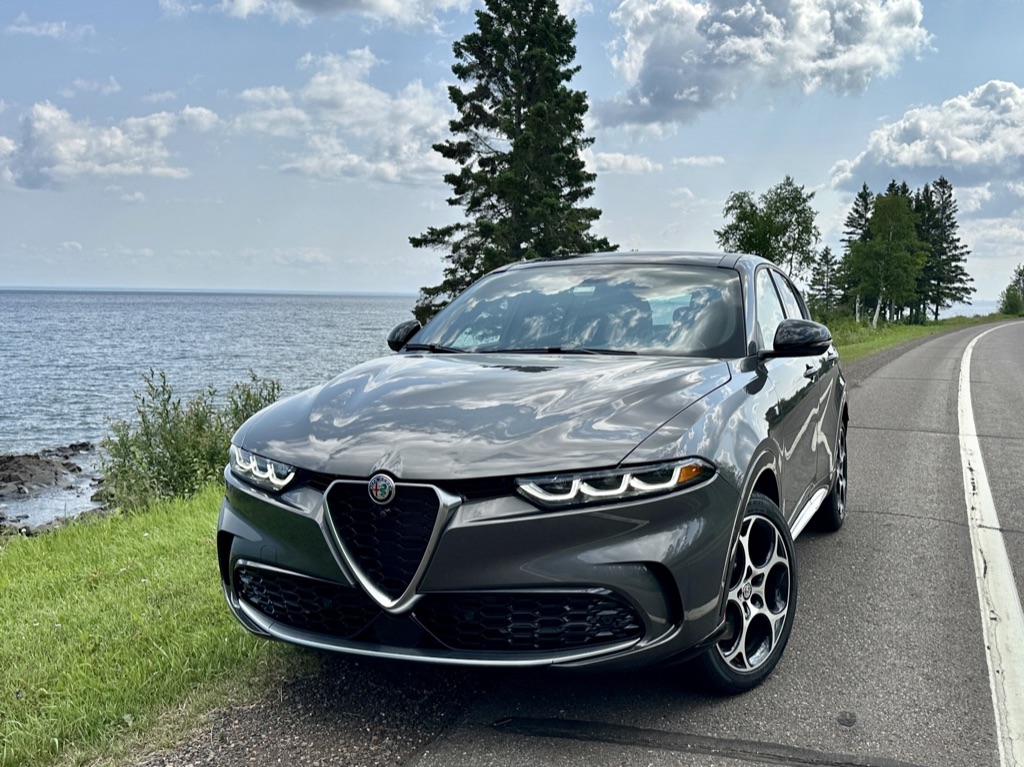


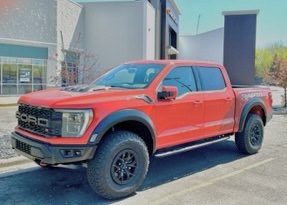

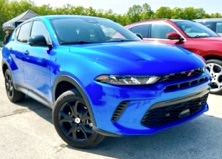


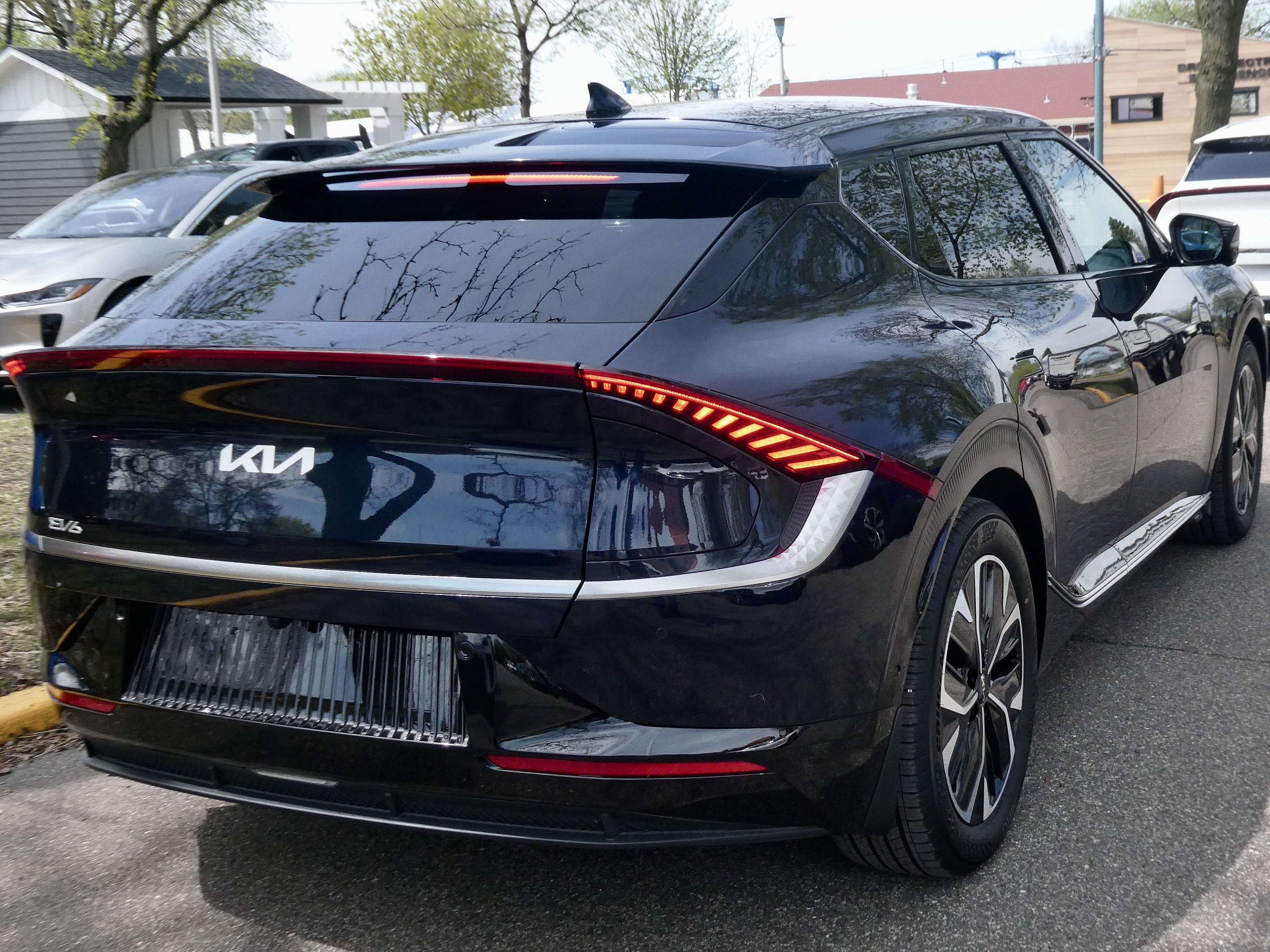
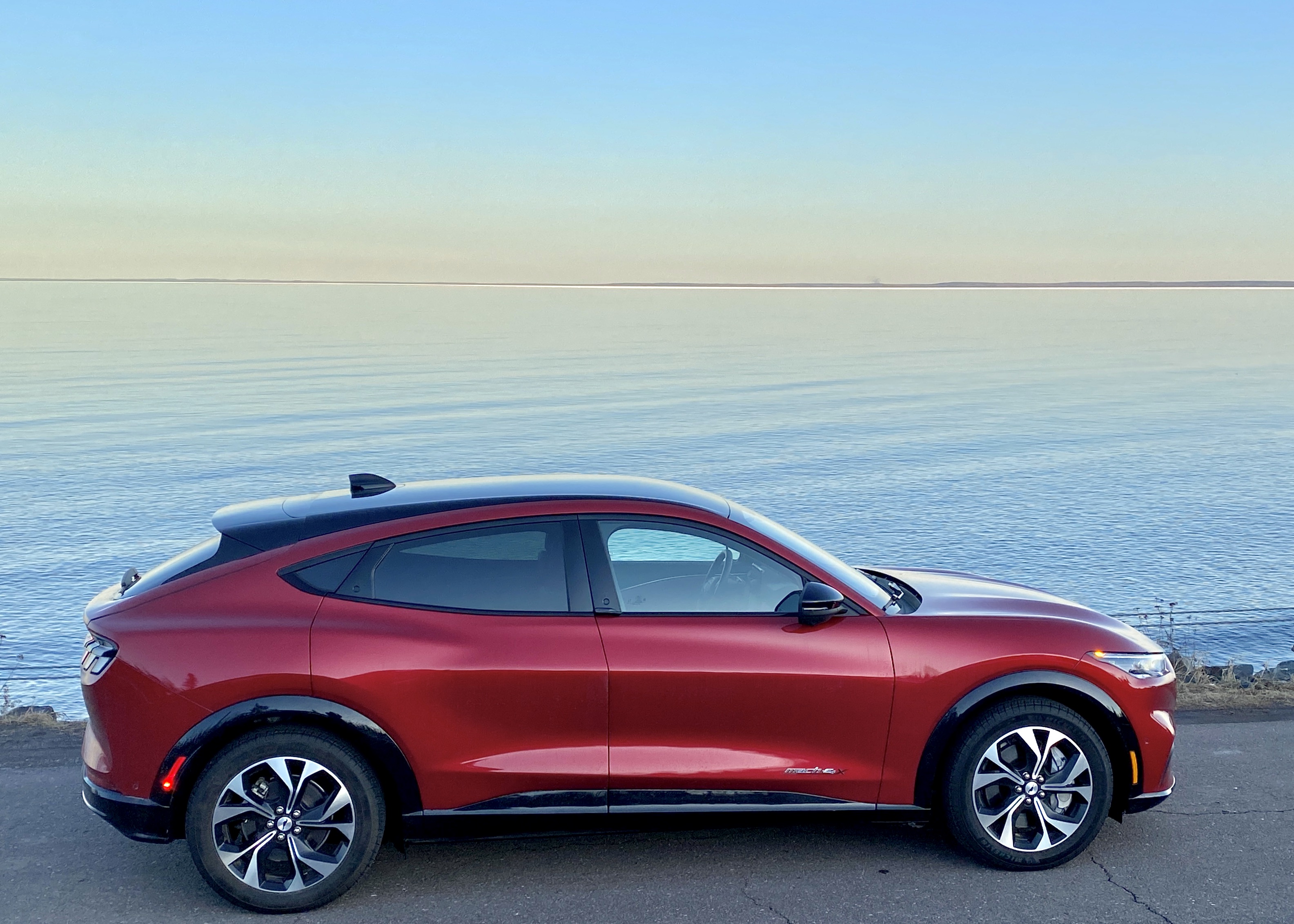
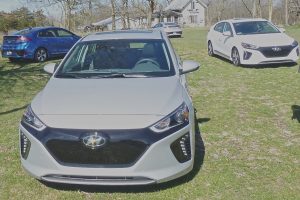
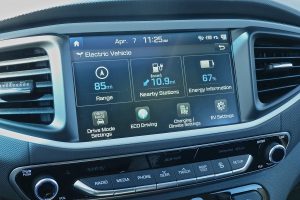
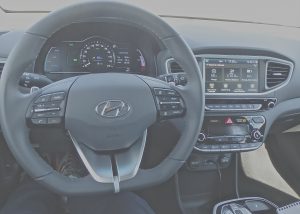
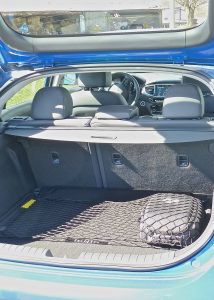
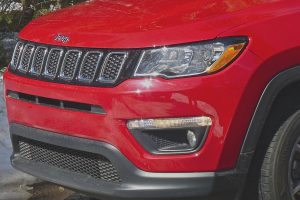
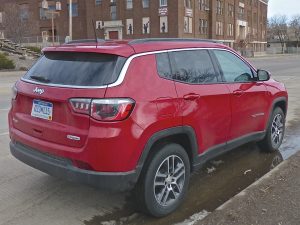

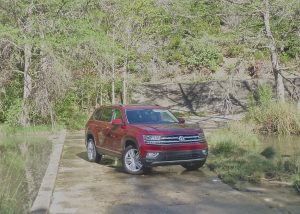

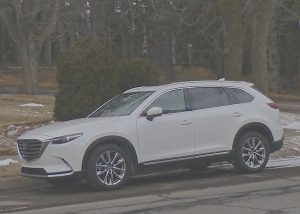
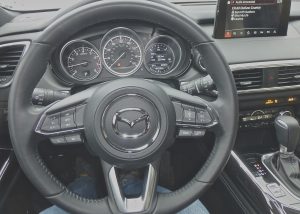
 John Gilbert is a lifetime Minnesotan and career journalist, specializing in cars and sports during and since spending 30 years at the Minneapolis Tribune, now the Star Tribune. More recently, he has continued translating the high-tech world of autos and sharing his passionate insights as a freelance writer/photographer/broadcaster. A member of the prestigious North American Car and Truck of the Year jury since 1993. John can be heard Monday-Friday from 9-11am on 610 KDAL(www.kdal610.com) on the "John Gilbert Show," and writes a column in the Duluth Reader.
John Gilbert is a lifetime Minnesotan and career journalist, specializing in cars and sports during and since spending 30 years at the Minneapolis Tribune, now the Star Tribune. More recently, he has continued translating the high-tech world of autos and sharing his passionate insights as a freelance writer/photographer/broadcaster. A member of the prestigious North American Car and Truck of the Year jury since 1993. John can be heard Monday-Friday from 9-11am on 610 KDAL(www.kdal610.com) on the "John Gilbert Show," and writes a column in the Duluth Reader.